de Havilland Dove
The de Havilland DH.104 Dove is a British short-haul airliner developed and manufactured by de Havilland. It was a monoplane successor to the prewar de Havilland Dragon Rapide biplane. The design came about from the Brabazon Committee report which, amongst other aircraft types, called for a British-designed short-haul feeder for airlines.[4]
| DH.104 Dove | |
|---|---|
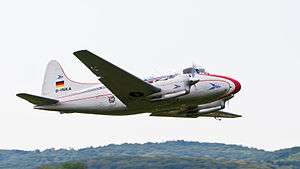 | |
| de Havilland Dove | |
| Role | short-haul airliner |
| National origin | United Kingdom |
| Manufacturer | de Havilland |
| First flight | 25 September 1945 |
| Status | Limited service |
| Produced | 1946–1967 |
| Number built | 544[1] |
| Unit cost | |
| Developed into | de Havilland Heron de Havilland Australia DHA-3 Drover |
The Dove was a popular aircraft and is considered to be one of Britain's most successful postwar civil designs, in excess of 500 aircraft being manufactured between 1946 and 1967. Several military variants were operated, such as the Devon by the Royal Air Force, the Sea Devon by the Royal Navy and the type also saw service with a number of overseas military forces.
A longer four-engined development of the Dove, intended for use in the less developed areas of the world, was the de Havilland Heron. A considerably re-designed three-engined variant of the Dove was built in Australia as the de Havilland Australia DHA-3 Drover.
Development and design
The development team for the Dove was headed by Ronald Eric Bishop,[4] the creator of the de Havilland Mosquito, a wartime fighter-bomber, and the de Havilland Comet, the first commercial jet aircraft in the world. It had been developed to meet the Type VB requirement issued by the Brabazon Committee.[5] In concept, the Dove was developed to be the replacement of the prewar de Havilland Dragon Rapide.[4] It was also required to be competitive with the large numbers of surplus military transports in the aftermath of the Second World War, such as the Douglas DC-3.[6] Unlike the Dragon Rapide, the Dove made use of a structure entirely of metal.[7][8] It also featured other innovations of the time, including constant-speed propellers, flaps, and a retractable tricycle undercarriage.[9][4]
In 1946, aviation magazine Flight praised the qualities of the newly developed Dove, noting its "modernity" as well as the aircraft's load-carrying capacity, safe engine-failure performance, and positive maintenance features.[5] Considerable attention was paid to aspects of maintainability, many of the components being designed to be interchangeable and easy to remove or replace, such as the rudder, elevator, and power units; other areas include the mounting of the engines upon four quick-release pickup points, the routing of cables and piping, and detachable wings and tail cone.[10] The extensive use of special Redux metal-bonding adhesives reduced the need for riveting during the manufacturing process, reducing overall weight and air-skin friction.[11]
While standard passenger versions of the Dove would carry between eight and eleven passengers, the cabin was designed to allow operators to convert between higher and lower density seating configurations.[12] Features such as a single aircraft lavatory and an aft luggage compartment could be removed to provide for increased seating capacity.[13] Various specialised models were produced for other roles, such as aerial survey, air ambulance, and flying classroom.[2] A strengthened cabin floor structure was used to enable concentrated freight loads to be carried as well.[12] The Dove could also serve as a dedicated executive transport, and in such a configuration it was capable of seating a total of five passengers; the executive model proved to be popular with various overseas customers, particularly those in the United States.[7]
The crew typically consisted of a pilot and radio operator. However, rapidly removable dual flight controls could be installed for a second flying crewmember instead.[5] A combination of large windows and a transparent perspex cabin roof provided a high level of visibility from the cockpit.[12][14] From a piloting perspective, the Dove was observed for possessing easy flying qualities and mild stall qualities.[15] A TKS anti-icing system was available for the Dove, involving an alcohol-based jelly delivered via porous metal strips embedded on the leading edges of the wings and tail.[14]
Operational service
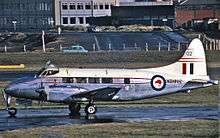
The Dove first flew on 25 September 1945.[4] In December 1946, the Dove entered service with Central African Airways.[8] Initial production of the Dove was performed at de Havilland's Hatfield factory, but from 1951 onwards, the aircraft were built at the company's Broughton facility near Chester.[16] The final example of the type was delivered in 1967. Production of the Dove and its variants totalled 544 aircraft,[1] including two prototypes, 127 military-orientated Devons and 13 Sea Devons.
From 1946 large numbers were sold to scheduled and charter airlines around the world, replacing and supplementing the prewar designed de Havilland Dragon Rapide and other older designs. The largest order for the Dove was placed by Argentina, which ultimately took delivery of 70 aircraft,[17] the majority of which were used by the Argentine Air Force. LAN Chile took delivery of twelve examples and these were operated from 1949 onwards until the aircraft were sold to several small regional airlines in the United States in 1954.[18]
In excess of 50 Doves were sold to various operators in the United States by Jack Riley, an overseas distributor for the type. De Havilland later assumed direct control of U.S. sales, however did not manage to match this early commercial success for the type.[19]
An early batch of 30 Devons was delivered to the Royal Air Force,[20] these aircraft were used as VIP and light transports for over 30 years. The Royal New Zealand Air Force acquired 30 Devons between 1948 and 1954 and these remained in service for VIP, crew-training and light transport duties into the 1970s.[18]
The Biafran Air Force operated a single Dove during the Nigerian Civil War, the aircraft was lost and subsequently found in 1970 on the premises of a school in Uli.[21] A second US-registered Riley Dove N477PM delivered in 1967 to Port Harcourt from Switzerland never reached Biafra because it was stopped by Algerian authorities.[21]
A few Doves and civilianised Devons remain in use in 2011 in the United Kingdom, Canada, Germany and elsewhere with small commercial firms and with private pilot owners.
Variants
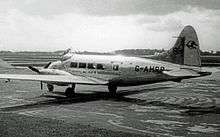
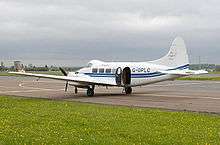
- Dove 1 : Light transport aircraft, seating up to 11 passengers. Powered by two 330 hp (250 kW)) de Havilland Gipsy Queen 70-3 piston engines.[22][23][20]
- Dove 2 : Executive transport version, seating up to six passengers. Powered by two 330 hp (250 kW) Gipsy Queen 70-3 piston engines.[23]
- Dove 3 : Proposed high-altitude survey version. Not built.[23]
- Dove 4 : Military transport and communications version.[23][20]
- Devon C Mk 1 : Transport and communications version for the RAF.[24]
- Devon C Mk 2 : Transport and communications version for the RAF. Re-engined version of the Devon C Mk 1 fitted with revised cockpit and two 400 hp (300 kW) Gipsy Queen 175 piston engines.[20]
- Sea Devon C Mk 20 : Transport and communications version for the Royal Navy.[24]
- Dove 5 : Uprated version of the Dove 1, seating up to 11 passengers, with two 380 hp (280 kW) Gipsy Queen 70 Mk2 piston engines.[23][25][20]
- Dove 6 : Uprated version of the Dove 2, six seat executive transport aircraft, powered by two 380 hp (280 kW) Gipsy Queen 70 Mk2 piston engines.[23][25][20]
- Dove 6B : Stressed for operations at a maximum weight of 8,500 lb (3,900 kg).[23]
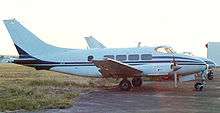
- Dove 7 : Uprated version of the Dove 5, seating up to 11 passengers, fitted with two 400 hp (300 kW) Gipsy Queen 70 Mk3 piston engines and revised cockpit.[20]
- Dove 8 : Uprated version of the six seat executive Dove 6, fitted with two 400 hp (300 kW) Gipsy Queen 70 Mk3 piston engines and revised cockpit.[20]
- Dove 8A : Five seater version of the Dove 8 for the U.S. market.[23]
- Dove Custom 800 : A customised version of the Dove, carried out by Horton and Horton in Fort Worth, Texas. Typically outfitted with removable bulkheads, various custom interiors were available, including airliner-orientated configurations.[26]
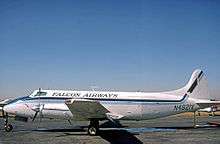
- Carstedt Jet Liner 600 : Conversions of the Dove, carried out by Carstedt Inc, of Long Beach, California, USA. The aircraft were fitted with two 605 hp (451 kW) Garrett AiResearch TPE331 turboprop engines. The fuselage was lengthened by 87 in (2,200 mm) to accommodate 18 passengers.[27][28] Only six aircraft were converted before one aircraft was lost due to a mid-air structural failure.[29]
- Riley Turbo Executive 400 / Riley Turbo-Exec 400 / Riley Dove 400 : Conversions of the Dove, carried out by Riley Aeronautics Corp in the United States.[30][31] The aircraft were fitted with two 400 hp (300 kW) Lycoming IO-720-A1A flat-eight piston engines. Riley conversions were fitted with a taller swept vertical fin and rudder but those retaining the standard DH fin were named Riley Dove 2. During the late 1960s, Riley Aeronautics, located at the Executive Airport in Fort Lauderdale, Florida, did interior refitting work on both the De Havilland Dove and the Heron.
Operators
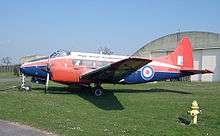
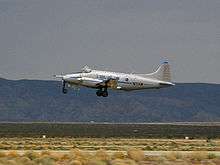
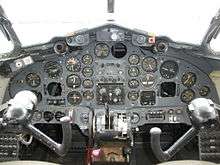
Civil operators
- Airlines of Western Australia
- Bay of Plenty Airlines
- MacRobertson Miller Airlines
- Mandated Airlines
- Northern Territory Medical Service
- Royal Flying Doctor Service
- Southern Airlines
- Union of Burma Airways[33]
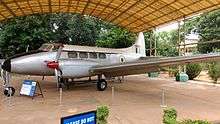
- Airways (India) Limited
- Indian National Airways
- Government of Madras
.svg.png)

.svg.png)

- Martinair (then called Martin's Air Charter)
Portuguese Angola
- AERANGOL - Aeronaves de Angola
- ETASA - Empresa de Transportes Aéreos do Sul de Angola
- SATAL - Sociedade Anónima de Transportes Aéreos
Portuguese Cape Verde
- ACCV - Aero Clube de Cabo Verde
- TACV - Transportes Aéreos de Cabo Verde
Portuguese Mozambique
- DETA - Divisão e Exploração de Transportes Aéreos[32]
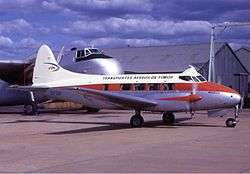
Portuguese Timor
- TAT - Transportes Aéreos de Timor[33]
- Comair (South Africa) operated 2 aircraft.
- South African Airways[32]
- Airviews Ltd
- BOAC (for training and communications)
- Bristow Helicopters
- British Midland
- British Westpoint Airlines
- Channel Airways (scheduled services)
- Dan-Air (scheduled services)
- Hunting-Clan Air Transport
- Macedonian Aviation
- Melba Airways
- Morton Air Services
- Olley Air Services
- Silver City Airways
- CAA Flying Unit
- Air Wisconsin
- Apache Airlines
- Catalina Airlines
- Golden Isles Airlines
- Gulf Coast Airways[34]
- Illini Airlines
- Midwest Air Charter
- National Test Pilot School
- Statewide Airlines
- Superior Airlines
- TAG Airlines
Military operators
- Argentine Air Force[35]
- Argentine Coast Guard[36]
- Argentine Federal Police
- Biafran Air Force – One Riley-converted Riley 400 was abandoned at Port Harcourt by Bristow Helicopters at the outbreak of civil war in 1967 and seized by Biafran mercenaries.[37]
- Royal Ceylon Air Force – Six series 5 delivered between 1955 and 1958.[35]
- Egyptian Air Force – Six series 1 delivered between 1947 and 1948.[35]
- Irish Air Corps – 4, one series 1B in 1953, one series 5 in 1959, one series 7 in 1962, and series 8 modified for radio and radar calibration in 1970.[35]
- Imperial Ethiopian Air Force – 3, two former Ethiopian government series 1 transferred to air force in 1952 and one new series 7 in 1965.[35]
- Royal Iraqi Air Force – 7 – One Series 1 for the Royal Flight delivered in 1947 followed by six Series 1 in 1948.[35]
- Royal Flight
- No. 3 Transport Squadron
- Royal Jordanian Air Force – 6 – Two Series 1 transferred from Jordan National Airlines, two aircraft intended for Jordan National Airlines converted to Series 5 and transferred to air force, two new Series 7s delivered in 1965[35]
- Royal Flight
- Kuwait Air Force – Two series 5 transferred to the air force in 1962.[35]
- Lebanese Air Force – One series 1 delivered in 1951, a further aircraft on order was not delivered.[35]
- Royal Malaysian Air Force- 5 – Three series 8 delivered in 1061 followed by two former RNZAF Devon C.1s delivered in 1968[35]
- Pakistan Air Force – Two, one former Government of Sind series 1 used until 1962, a new VIP series 2 delivered in 1949.[35]
- No. 12 Squadron
- Paraguayan Air Force- One former Argentine Air Force series 1 delivered in 1963.[35]
- South African Air Force – Nine series 1 delivered in 1949.[35]
- No. 28 Squadron
- Swedish Air Force – One Series 1 delivered in 1947 and sold in 1967.[35]
- Aeroplane and Armament Experimental Establishment
- Empire Test Pilots' School
- Royal Aircraft Establishment
- Royal Air Force- 30 series 4 aircraft as the Devon C.1 from 1948.[35]
- No. 21 Squadron RAF
- No. 26 Squadron RAF
- No. 31 Squadron RAF
- No. 32 Squadron RAF
- No. 60 Squadron RAF
- No. 207 Squadron RAF
- Bomber Command Communications Squadron
- Coastal Command Communication Squadron
- Maintenance Command Communications Squadron
- Metropolitan Communications Squadron
- Northern Communications Squadron
- Queen's Flight
- Southern Communications Squadron
- Technical Training Command Communications Flight
- Western Communications Squadron
- Royal Radar Establishment at Pershore
- Fleet Air Arm – Ten former civil aircraft delivered in 1955 as the Sea Devon C.20, later another three were bought.
- Venezuelan Air Force – One former civil series 2A transferred to air force in 1968.[35]
- SFR Yugoslav Air Force – Two former Jugoslav Air Transport series 2B transferred to air force.[35]
Aircraft on display
- Argentina
.jpg)
- F-12 of the Argentine Air Force is on display at the Museo Nacional de Aeronautica de Argentina (National Aeronautics Museum), Moron Airport, Buenos Aires, Argentina
- Australia
- VH-MAL Queensland Air Museum, Caloundra. (Previously VP-KEJ with East African Airways).
- India
- Devon HW-201 is on display at the HAL Aerospace Museum at Bengaluru, India.
- Devon IN-124 is on display at the Naval Aviation Museum at Bogmalo, Goa.
- The Netherlands
- New Zealand
- Royal New Zealand Air Force Museum, Wigram, Christchurch.
- Devon NZ1829 is at the Ashburton Aviation Museum, Ashburton[39]
- New Zealand Warbirds, Ardmore, Auckland.[40]
- South Africa
- ZS-BCC a Dove 6 of South African Airways is on display at the South African Airways Museum, Rand Airport, Germiston, South Africa.[41]
- United Kingdom
- D-IFSB a Dove 8 is on display at the De Havilland Aircraft Heritage Centre, London Colney, England.[42]
- G-AHRI a Dove 1 is on display in Iraqi Petroleum markings at the Newark Air Museum, Newark-upon-Trent, England.[43]
- G-ALCU a Dove 1 is on display as G-ALVD in Dunlop markings at the Midland Air Museum, Coventry, England.[44]
- G-ALFU a Dove 6 formerly of the Civil Aviation Flying Unit is on display at Duxford Aerodrome, England.[45]
- G-ANOV a Dove 6 is on display at the National Museum of Flight, East Fortune, Scotland.[46]
- G-ANUW a Dove 6 is on display at the Aeropark at East Midlands Airport, England.[47]
- G-AREA a Dove 8 in British Aerospace markings is on display at the De Havilland Aircraft Heritage Centre, London Colney, England.[48]
- VP967 a Devon C.2 in Royal Air Force markings is on display at the Yorkshire Air Museum, Elvington, England.[49]
United States
Accidents and incidents
- On 13 May 1948, a Dove 1 G-AJOU of Skyways Limited crashed near Privas, France, all four of the people on board killed, including the Earl Fitzwilliam and Kathleen Cavendish, the second daughter of Joseph P. Kennedy.[51]
- On 14 March 1949, a De Havilland DH.104 Dove 1 of Union of Burma Airways, registration XY-ABO, crashed in Gulf of Mottama (Martaban) en route from Mingaladon Airport to Moulmein (Mawlamyine) Airport. Lost 9 passengers and 2 crew (Capt P H Sparrow, Pilot and L.A. Stephens, Radio officer).[52]
- On 15 October 1951, Dove VH-AQO operated by Airlines (WA) Ltd crashed near its destination, Kalgoorlie, Western Australia, on a flight from Perth. All seven occupants were killed. The accident was eventually attributed to fatigue cracking of the wing spar.[53]
- On 12 November 1953, Argentine Air Force Dove T-82 crashed mid-air with Junkers Ju 52 T-159 near Villa Mugueta, Santa Fe, Argentina; with no survivors. Among the 20 dead was Vicecommodore Gustavo Argentino Marambio, pioneer of Argentine flights to Antarctica.[54][55]
- On 1 December 1954, a Dove 2B VH-DHD of De Havilland Australia crashed at Narellan, near Camden, Australia. Reginald Adsett, a chief examiner of airman for the Australian Civil Aviation Department was killed. Two other were seriously injured.[56]
- On 15 January 1958, Dove G-AOCE of Channel Airways crashed on approach to Ferryfield Airfield, Lydd, Kent, United Kingdom, both engines having stopped due to fuel starvation due to fuel mismanagement. All seven people on board survived.[57]
- On 13 April 1966, Abdul Salam Arif, the President of Iraq, was killed when the Iraqi Air Force de Havilland DH.104 Dove 1, RF392, he was onboard crashed in southern Iraq. The loss of the aircraft was suspected to be due to sabotage by Ba'athist elements within the Iraqi military.[58]
- On 11 April 1968, Dove 1 Z-900 of the Egyptian Air Force was lost over the Sahara desert following instrument failure. The aircraft was not found until 1 June 1971, all nine occupants had died of starvation.[59]
- On 28 January 1970, TAG Airlines Flight 730 crashed over Lake Erie after having suffered an inflight structural failure, killing all nine people aboard.[60]
- On 6 May 1971, Apache Airlines Flight 33 from Tucson, AZ to Phoenix, AZ crashed near Coolidge, AZ after suffering an inflight structural failure, killing all twelve people aboard.[61]
- On 9 July 1983 a privately owned Dove, G-AMYP, suffered engine failure on takeoff at Shoreham Airport, crashing into the banks of the River Adur. The pilot and sole occupant, Keith Wickenden, died on impact.[62]
- On 3 December 1993, a Dove VH-DHD chartered dinner flight lost engine power during takeoff, resulting in the aircraft crashing into five houses in Essendon – a suburb containing the original airport for Melbourne Australia. There were no fatalities amongst either the ten occupants of the Dove nor anyone on the ground, but all aboard the aircraft and one pedestrian were taken to hospital.[63]
- On 3 February 2006, New Zealand based Devon, ZK-UDO (ex-RNZAF Devon 21) suffered a hard landing at RNZAF Base Ohakea due to an asymmetrical flap deployment on approach. All passengers and crew survived with only minor injuries; the aircraft was damaged beyond economical repair.
Appearances in fiction
A de Havilland Dove featured prominently in the Gavin Lyall adventure novel Shooting Script. G-ARBH features in the 1962 film The Wrong Arm of the Law as the personal aeroplane of Peter Sellers' character Pearly Gates. Near the beginning of the 1980 film Flash Gordon (film) travel agent Dale Arden and New York Jets quarterback Flash Gordon board a de Havilland Dove which subsequently crashed into a greenhouse adjacent to the secret laboratory of Dr. Hans Zarkov. The atmospheric disturbances that caused the crash were instigated by planet Mongo's ruler Ming the Merciless. The crash sequence was filmed using a 30-inch-long model Dove diving into a miniature landscape.[64]
Specifications (Dove 7)
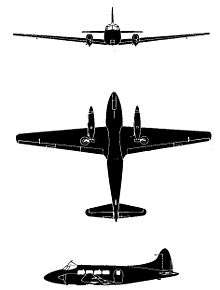
Data from Flight International,[12] Jane's All The World's Aircraft 1966–67,[65] Jane's All the World's Aircraft 1967-68[66]
General characteristics
- Crew: 2
- Capacity: 8 passengers / 1,477 lb (670 kg) max payload
- Length: 39 ft 3 in (11.96 m)
- Wingspan: 57 ft 0 in (17.37 m)
- Height: 13 ft 4 in (4.06 m)
- Wing area: 335 sq ft (31.1 m2)
- Airfoil: root:RAF 34 mod (18.3%) ; tip: RAF 34 mod (14.5%)[67]
- Empty weight: 6,325 lb (2,869 kg)
- Max takeoff weight: 8,950 lb (4,060 kg)
- Maximum landing weight: 8,500 lb (3,856 kg)
- Fuel capacity: 168 imp gal (202 US gal; 764 l) in four wing tanks, with provision for a 52 imp gal (62 US gal; 236 l) in the rear luggage compartment
- Powerplant: 2 × de Havilland Gipsy Queen 70 Mk.3 6-cylinder air-cooled inverted in-line piston engines, 400 hp (300 kW) each
- Propellers: 3-bladed Hawker Siddeley Hydromatic, 7 ft 6 in (2.29 m) diameter constant-speed feathering propellers
Performance
- Maximum speed: 230 mph (370 km/h, 200 kn)
- Cruise speed: 187 mph (301 km/h, 162 kn) maximum at 8,000 ft (2,438 m) and 8,500 lb (3,856 kg) AUW
- 187 mph (162 kn; 301 km/h) economical, 60% power, 8,000 ft (2,438 m) and 8,500 lb (3,856 kg) AUW
- Stall speed: 74 mph (119 km/h, 64 kn) flaps and gear down
- 94 mph (82 kn; 151 km/h) flaps up
- Range: 880 mi (1,420 km, 760 nmi) full fuel, 1,398 lb (634 kg) payload, 45 minutes hold and 5% reserve
- 385 mi (335 nmi; 620 km) full fuel, 2,000 lb (907 kg) payload, 45 minutes hold and 5% reserve
- Service ceiling: 21,700 ft (6,600 m)
- Rate of climb: 1,135 ft/min (5.77 m/s) at sea level
- 295 ft/min (1.5 m/s) with one engine inoperative
- Wing loading: 26.7 lb/sq ft (130 kg/m2)
- Power/mass: 0.0893 hp/lb (0.1468 kW/kg)
- Take-off distance to 50 ft (15 m): 2,320 ft (707 m)
- Landing distance from 50 ft (15 m): 1,910 ft (582 m)
References
Notes
- https://www.baesystems.com/en/heritage/de-havilland-dh104-dove---devon
- "Commercial Aircraft 1953." Flight International, 6 March 1953. p. 304.
- Schlaeger September 1961, p. 31.
- Jackson 1987, p. 443.
- de Havilland Dove 30 May 1946. p. 547a.
- The de Havilland Dove 12 April 1945, p. 399.
- Jerram, Mike. "The last de Havilland." Flying Magazine, 120 (9). p. 43.
- "Hawker Siddeley Aviation." Flight International, 26 November 1964. p. 919.
- "de Havilland Heron." Flight International, 22 January 1954. p. 97.
- de Havilland Dove 30 May 1946. pp. 547b-547d.
- de Havilland Dove 30 May 1946. p. 547d.
- de Havilland Dove 30 May 1946. p. 547.
- The de Havilland Dove 12 April 1945, p. 400.
- Schlaeger September 1961, p. 64.
- Schlaeger September 1961, p. 66.
- Jackson 1987, p. 444.
- Jackson 1987, p. 445.
- Sykes 1972
- Collins, Richard L. "On Top: Life of Riley." Flying Magazine, April 1975. 96(4). p. 8.
- Jackson 1987, p. 446.
- Cooper, Tom. "Civil War in Nigeria (Biafra), 1967–1970." Acig.org 13 November 2003.
- Gunston 1980, p. 158.
- Stemp 2011, p. 117.
- Stemp 2011, p. 119.
- Gunston 1980, p. 159.
- Schlaeger September 1961, pp. 30–31.
- "Carstedt Jet Liner 600", Flight International, p. 85, 19 January 1967
- Gunston 1980, pp. 159, 238.
- https://aviation-safety.net/database/record.php?id=19710506-0
- Jane 1972, p. 432.
- http://www.rileydove.com/
- Stroud 1994, p. 67.
- Stroud 1994, p. 68.
- "Gulf Coast Airways Timetable (July 1, 1958)". Airline Timetable Images. Bjorn Larsson and David Zekria. Retrieved 30 July 2017.
- Sykes 1973, p. 56-60
- "F-12 (cn 04156)". airliners.net, 11 February 2006. Retrieved: 11 October 2011.
- Sykes 1973, p. 22
- "Congo, Part 1; 1960–1963". ACIG. 2003.
- https://www.aviationmuseum.co.nz/cms/index.php/museum-exhibiits#!2
- https://nzwarbirds.org.nz/gallery/warbirds-family-album/DH104+Devon.html
- "de Havilland DH 104 Dove – ZS-BCC." saamuseum.co.za, Retrieved: 25 May 2014.
- Ellis 2012, p. 77
- Ellis 2012, p. 1 72
- Ellis 2012, p. 257
- Ellis 2012, p. 21
- Ellis 2012, p. 286
- Ellis 2012, p. 94
- Ellis 2012, p. 76
- Ellis 2012, p. 272
- "Aircraft of the Mid-Atlantic Air Museum". www.maam.org. Retrieved 29 January 2020.
- "Rich Peer Victim of French Crash; Lord Fitzwilliam on Airplane With Kennedy's Daughter – Ex-Envoy Leaves Paris." The New York Times, 14 May 1948.
- Ranter, Harro. "ASN Aircraft accident 14-MAR-1949 de Havilland DH.104 Dove 1 XY-ABO". aviation-safety.net. Retrieved 13 August 2017.
- Job, Macarthur (1992). Air Crash Vol. 2. pp 133–140: Aerospace Publications Pty. Ltd.CS1 maint: location (link) CS1 maint: ref=harv (link) Fyshwick, Australia. ISBN 1-875671-01-3
- "Accidente aéreo del Vicecomodoro Gustavo Argentino Marambio" – Fundacion Marambio website (in Spanish)
- "El DH-104 Dove en Argentina", Rumbos Aeronauticos digital (12 May 2017) (in Spanish)
- "Pilot fatally hurt in crash." Sydney Morning Herald, 2 December 1954.
- Moor, Anthony. "A Dove down at Dungeness". Aeroplane. No. April 2012. Cudham: Kelsey Publishing. pp. 98–100. ISSN 0143-7240.
- "Abdel-Rahman Aref, 91, Former Iraqi President, Is Dead." The New York Times, 25 August 2007.
- Sykes 1973, p. 22.
- "Aircraft Accident Report TAG Airlines, Inc. de Havilland Dove (DH-104), N2300H, in Lake Erie." Archived 4 October 2012 at the Wayback Machine National Transportation Safety Board, 28 January 1971. NTSB-AAR-71-5.
- National Transportation Safety Board NTSB Identification: LAX71AL066
- http://sussexhistoryforum.co.uk/index.php?topic=1816.0
- Smith, Dwight. "1993: Essendon plane crash; Residents anger grows." Archived 24 July 2014 at the Wayback Machine The Weekly Review: Moonee Valley, 7 December 1993.
- https://modelaircraftinthecinema.blogspot.com/2019/04/flash-gordon-1980.html
- Taylor, John W.R., ed. (1966). Jane's All the World's Aircraft 1966-67 (57th ed.). London: Sampson Low, Marston & Co. Ltd. pp. 150–151.
- Taylor, John W.R., ed. (1967). Jane's All the World's Aircraft 1967-68 (58th ed.). London: Sampson Low, Marston & Co. Ltd. p. 159.
- Lednicer, David. "The Incomplete Guide to Airfoil Usage". m-selig.ae.illinois.edu. Retrieved 16 April 2019.
Bibliography
- "de Havilland Dove." Flight International, 30 May 1946. pp. 547a-547e.
- Ellis, Ken. Wrecks & Relics, 23rd Edition. Manchester, England: Crecy Publishing, 2012. ISBN 9 780859 791724.
- Gunston, Bill. The Illustrated Encyclopedia of Propeller Airliners. Exeter Books, 1980. ISBN 0-896-73078-6.
- Jackson, A.J. de Havilland Aircraft since 1909. London: Putnam & Company Ltd, 1978. ISBN 0-370-30022-X.
- Jackson, A.J. de Havilland Aircraft since 1909. London: Putnam, Third edition, 1987. ISBN 0-85177-802-X.
- Jane, Frederick Thomas. Jane's All the World's Aircraft. Sampson Low, Marston & Company, 1972.
- Schlaeger, Gerald J. "de Havilland Dove Custom 800." Flying Magazine, September 1961. Vol. 69, No. 3. pp. 30–31, 64, 66.
- Stemp, P. D. "Kites, Birds & Stuff – de Havilland Aircraft." Lulu.com, 2011. ISBN 1-447-77679-8.
- Stroud, John. "Post War Propliners: de Havilland Dove". Aeroplane Monthly, Vol. 22, No. 10, October 1994. pp. 64–69.
- Sykes, T. (editor) The DH104 Dove and DH114 Heron Tonbridge, Kent, UK: Air-Britain (Historians) Ltd, 1973.
- "The de Havilland Dove." Flight International, 12 April 1945. pp. 399–400.
- Taylor, John W. R. Jane's All The World's Aircraft 1966–67. London: Sampson Low, Marston & Company, 1966.